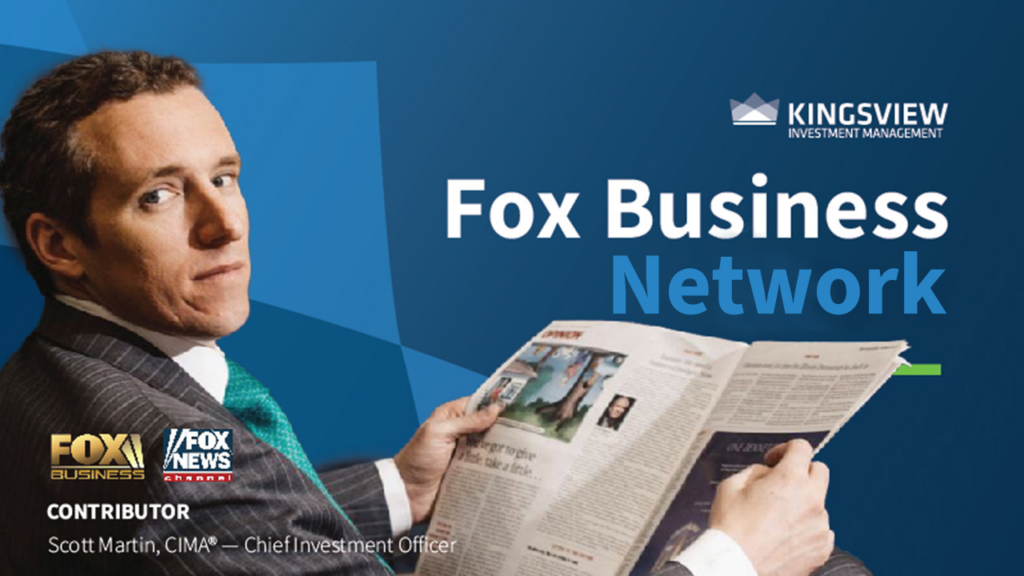Kingsview CIO Scott Martin On Fox Business Your World with Cavuto 6.25.2024

Click here to listen to the full interview.
Segment 1:
ASHLEY WESTER: Kingsview Asset Management CIO Scott Martin and Optimal Capital Director of Strategy Frances Newton Stacy are both here. Welcome to you both. Scott, let me begin with you. What is your reaction to the Fed Governor’s comment that they could even hike rates?
SCOTT MARTIN: That’s something I guess the market needs to come to grips with. Ms. Bowman may be trying to steal a headline or two on kind of a slow news day, at least an Nvidia news day as you led in the intro there. But look, the reality is the Fed should be saying that, and that’s one thing that I think the market all year has been getting wrong, at least experts have been offside on this prediction. At first, we were going to get six cuts, then four, then two. As you know, my mantra has been zero this year, and that is a good thing. If the Fed has to cut rates, boys and girls, there’s probably something wrong or something has overheated in the economy, or maybe something has slowed down in the banks, and that’s not what we want. So when the Fed says, “Hey, we might raise or we might cut,” that’s actually a great thing because the market can realize Fed rates staying right here. By the way, Ashley, open market interest rates have been falling over the last couple of months as we’ve had pretty benign inflation data, which is already doing the work for the Fed, so they don’t have to cut by the end of the year.
ASHLEY WESTER: Frances, your take on the market’s been very complacent. And to Scott’s point, I think there are as many as seven rate cuts being predicted. Now they’re thinking maybe September would be the last opportunity before the November election. What do you say?
FRANCES NEWTON STACY: Okay, so it’s always really a lot of fun to debate Scott, but I actually agree entirely with you, Scott. The thing is that the Fed doesn’t need to cut rates because we have relative stability, even with softening inflation. And as Scott said, this is beginning to be priced in and interest rates are traded via bond market dynamics more than with the Fed. The problem with the Fed is that you have two governors say something dovish and two governors say something hawkish so that you balance out, so the markets don’t wildly try to parse through the Fed data and create volatility in the rate environment. The other thing is that Bowman talked about some risks in either a continuation of inflation or a reversal in inflation, and those risks are owner’s equivalent rent, which has a huge lag going into CPI and is a third of CPI. It’s also the Shanghai Container Freight Index, and that’s up 240% year over year and has a massive lag. So it’s easier for them to now sort of introduce this conversation about a rate hike when they see genuine risks in the data.
ASHLEY WESTER: I’ve got 30 seconds from both of you. We’re heading into the third quarter, kind of summer doldrums a little bit. Scott, how do the markets play out from here? Still a ton of cash on the sidelines. We know that. We also have a presidential election hanging over us.
SCOTT MARTIN: Yeah, trillions, in fact, Ashley, and it should be summer doldrums, but in fact, we’re seeing wild volatility swings in some of these individual stocks depending on what you follow. So I think it’s more of that scenario where stocks are going to go up, they’re going to go down, but they’re going to be more volatile, especially as some of that cash comes off the sidelines and then goes in and then goes back on the sidelines. Investors will decide at these lofty valuations what they’re going to do into November.
ASHLEY WESTER: And quickly, Frances, these markets have just continued to grind higher. Do you expect that to continue?
FRANCES NEWTON STACY: Yes, because there’s plenty of liquidity. The fiscal spending hasn’t slowed, the private credit interest hasn’t slowed, but I will say one more thing about rates. The Fed has an incentive to keep rates high to keep demand in the bond markets to fund this debt and these deficits. And so that’s an important factor that many people don’t comment on.
ASHLEY WESTER: Alright, Scott and Frances, stay there. Frances, you’ll get to debate Scott again a little later in the show. Oh yeah, we’ll bring it on. Stay right there.
Segment 2:
ASHLEY WEBSTER: Nvidia is rallying and rising out of correction territory after yesterday’s nosedive that wiped out more than $400 billion from its value. Let’s bring back our market watchers, Scott Martin and Frances Newton Stacy. Thank you both for sticking around. Frances, I’ll begin with you. Are we seeing some signs of exhaustion in the big semiconductors, particularly Nvidia? Or is this just a healthy pause, and now they can move to the next leg up?
FRANCES NEWTON STACY: Well, the thing is that, generally speaking, the fundamental story is very, very strong. There is a tremendous amount of demand for their chips, and they have locked up the intellectual property that will keep competitors at bay for a while. However, on the flip side, Nvidia has become the panacea for making up and compensating for all other stock market, labor, and growth and inflation risks. To that extent, it could become very frothy because it’s just gone up at an unsustainable angle, and that’s why things sort of revert back to the mean so they can get into a more sustainable rate of growth.
ASHLEY WEBSTER: What do you say, Scott? A little frothy?
SCOTT MARTIN: Just a bit, Ashley, like my coffee. As I mentioned earlier this morning, I can’t disagree with Frances here either. She’s correct. She mentioned fundamentals—how does 150% revenue growth sound, how does 120% free cash flow growth sound, how does net profit margin, all these fun things to talk about with people at bars—net profit growth at 200% sound? That’s Nvidia, boys and girls. The problem is that the stock has gone crazy and has lifted a lot of other stocks for no reason other than it’s just Nvidia. When you have clients, both of our firm and potential clients, saying, “Hey, how much Nvidia are we going to buy?” in the first 10 minutes of the conversation, it reminds me of 2007 and 1999 when some of those high-flyer stocks that seemed like can’t-misses started to turn over and get fatigued, indicating it might be time to start to lighten up.
ASHLEY WEBSTER: Yeah, Frances, yesterday we saw a lot of that money coming out of Nvidia and other semiconductors and going into energy and banks. Overall, isn’t that healthier for the market to have more broad-based growth?
FRANCES NEWTON STACY: It is definitely healthier for the market, but just in the interest of sort of debating this issue, Nvidia is a fabulous company, but the rate at which it’s expanded is kind of unsustainable. Global macro always trumps stock fundamentals. If something changes with inflation or growth or if we have credit problems, Nvidia, despite its strong fundamentals, will definitely sell off. You lower your risk by rebalancing when things get a little frothy, and it sounds like Scott’s having these fun conversations with clients just as we are.
ASHLEY WEBSTER: Very quickly, Scott, is there anyone else in that space other than Nvidia that you like? It gets all the headlines.
SCOTT MARTIN: Yeah, it’s funny, Ashley. Ones that we’ve recommended just on the side, as Frances said, to take off a little bit of the froth from Nvidia are AMD and Taiwan Semiconductor. These are companies that have valuations that are one-fifth of Nvidia and still have a great business but are not as popular. These could catch up easily as some of the regulations come in and as market volatility increases.
ASHLEY WEBSTER: Very good. We’ll leave it there. Scott, Frances, it’s always a very frothy conversation, which we always enjoy. Look forward to next time. Thank you both.
Segment 3:
ASHLEY WEBSTER: Nvidia is rallying and rising out of correction territory after yesterday’s nosedive that wiped out more than $400 billion from its value. Let’s bring back our market watchers, Scott Martin and Frances Newton Stacy. Thank you both for sticking around. Frances, I’ll begin with you. Are we seeing some signs of exhaustion in the big semiconductors, particularly Nvidia? Or is this just a healthy pause, and now they can move to the next leg up?
FRANCES NEWTON STACY: Well, the thing is that, generally speaking, the fundamental story is very, very strong. There is a tremendous amount of demand for their chips, and they have locked up the intellectual property that will keep competitors at bay for a while. However, on the flip side, Nvidia has become the panacea for making up and compensating for all other stock market, labor, and growth and inflation risks. To that extent, it could become very frothy because it’s just gone up at an unsustainable angle, and that’s why things sort of revert back to the mean so they can get into a more sustainable rate of growth.
ASHLEY WEBSTER: What do you say, Scott? A little frothy?
SCOTT MARTIN: Just a bit, Ashley, like my coffee. As I mentioned earlier this morning, I can’t disagree with Frances here either. She’s correct. She mentioned fundamentals—how does 150% revenue growth sound, how does 120% free cash flow growth sound, how does net profit margin, all these fun things to talk about with people at bars—net profit growth at 200% sound? That’s Nvidia, boys and girls. The problem is that the stock has gone crazy and has lifted a lot of other stocks for no reason other than it’s just Nvidia. When you have clients, both of our firm and potential clients, saying, “Hey, how much Nvidia are we going to buy?” in the first 10 minutes of the conversation, it reminds me of 2007 and 1999 when some of those high-flyer stocks that seemed like can’t-misses started to turn over and get fatigued, indicating it might be time to start to lighten up.
ASHLEY WEBSTER: Yeah, Frances, yesterday we saw a lot of that money coming out of Nvidia and other semiconductors and going into energy and banks. Overall, isn’t that healthier for the market to have more broad-based growth?
FRANCES NEWTON STACY: It is definitely healthier for the market, but just in the interest of sort of debating this issue, Nvidia is a fabulous company, but the rate at which it’s expanded is kind of unsustainable. Global macro always trumps stock fundamentals. If something changes with inflation or growth or if we have credit problems, Nvidia, despite its strong fundamentals, will definitely sell off. You lower your risk by rebalancing when things get a little frothy, and it sounds like Scott’s having these fun conversations with clients just as we are.
ASHLEY WEBSTER: Very quickly, Scott, is there anyone else in that space other than Nvidia that you like? It gets all the headlines.
SCOTT MARTIN: Yeah, it’s funny, Ashley. Ones that we’ve recommended just on the side, as Frances said, to take off a little bit of the froth from Nvidia are AMD and Taiwan Semiconductor. These are companies that have valuations that are one-fifth of Nvidia and still have a great business but are not as popular. These could catch up easily as some of the regulations come in and as market volatility increases.
ASHLEY WEBSTER: Very good. We’ll leave it there. Scott, Frances, it’s always a very frothy conversation, which we always enjoy. Look forward to next time. Thank you both.

